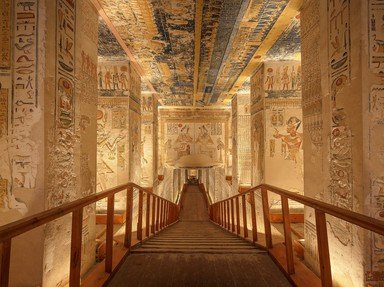Quiz Answer Key and Fun Facts
1. In the first plague the waters of Egypt were turned to blood. There were many gods associated with the waters of Egypt, especially the Nile River. Which god did the Egyptians believe was the guardian of the Nile?
2. In the second plague frogs descended on the land of Egypt. Frogs were found everywhere. Which god was physically represented as a frog to the Egyptians?
3. The third plague was the plague of the lice (also translated sand flies and fleas in some versions). This plague was an affront to the god Geb, the creator of the earth. Because of this plague the priests could not
4. The fourth plague was the plague of the swarms. Translators have added "of flies" to the Biblical text to make it clearer; however, the swarms were most likely swarms of Scarab Beetles. Which Egyptian god is represented with the head of the Scarab Beetle?
5. Plague number 5 was the plague that caused disease among the livestock. This plague was an affont to Apis, Ptah, Re and Hathor. Apis is represented as a
6. Plague six: Boils. The Egyptians were stricken with boils on their legs, knees and feet. Even the magicians of Pharaoh could not stand before Moses (Exodus 9:11). This plague was an affront to two Egyptian gods. Can you name them?
7. Plague 7 was the plague of hail. Several gods were insulted by this plague. Which two Egyptian gods were charged with the protection of crops?
8. Plague number 8: Locusts. Locusts could destroy entire crops in a matter of minutes. Joel 1:6 describes locusts as "an army." Besides being an affront to Seth and Isis, who were protectors of crops, this plague would also be an insult to the god of grain. Do you know the name of this deity?
9. 9: Darkness. A plague of darkness would have been an insult to culture and religion in Egypt. The sun god, Amon-Ra, was considered one of the most powerful of the gods. How was this god represented in Egyptian art?
10. The final plague: The Death of the Firstborn. This was the last straw for poor Pharaoh who finally decided to let the people go. While many gods would have been shown to be ineffective by this plague, one particular god was believed to be the guardian of life. Who was it?
Source: Author
sfasu1999
This quiz was reviewed by FunTrivia editor
CellarDoor before going online.
Any errors found in FunTrivia content are routinely corrected through our feedback system.

